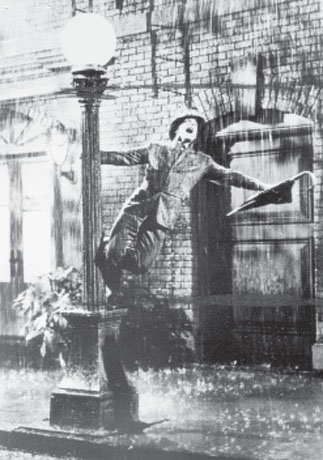The art of soaking stars for cinematic effect

Gene Kelly dances in the rain holding an umbrella, a famous scene from “Singing in the Rain.”
Case in point: In the movie “Singing in the Rain,” Gene Kelly celebrates his newfound love by throwing his umbrella in the air and performing his now-famous dance in the drizzle. And in one pop song whose name escapes me, the singer laments that rain always pours after a sad break-up.
It’s a big, fat cliche for directors to introduce rain in these situations, but they do it anyway. So let’s not focus on how using trickling water to portray sadness is so commonplace.
Because of rain’s overuse as a cinematic effect, people may think that it’s easy to produce a rain shower on a movie set. But in reality, it can be quite troublesome. For outdoor sets, machines such as motor sprinklers are required. Including labor, it costs 1.2 million won ($948) for just one scene.
It’s even harder to make rain in a Hollywood studio. In the movie “Streets of Fire,” starring Diane Lane and Michael Pare, a fake street was built in a huge studio equipped with water pipes from which artificial rain fell. But the end result - a passionate, rain-soaked kiss - was worth all the money and effort.
Rain is also used in sci-fi films to hide the fact that computer graphics or mock sets are used. In the Ridley Scott-directed film “Blade Runner,” which stars Harrison Ford, Rutger Hauer and Sean Young, rain is constantly pouring.
In the movie “The Matrix,” it rains during a fight scene between Neo (Keanu Reaves) and Agent Smith (Hugo Weaving). Without the rain, the computer graphics would have looked far less realistic to viewers.
Rain is often used to dramatize action as well. In the case of the Korean film “Nowhere to Hide,” actors Ahn Sung-kee and Park Joong-hoon trade blows during a squall in the very last scene.
As one man lands a punch, water splashes off the unlucky man’s face. Without the rain, the scene would hardly have had the same dramatic effect.
Interestingly, whenever rain is portrayed in films, it has to be pouring, not just sprinkling.
Actual rain is way too light to be visible on the screen. This effect is best seen in the film “The Shawshank Redemption” when Andy Dufresne (Tim Robbins) embraces the pouring rain with his arms wide open upon escaping from prison.
By Cho Won-hee Contributing Writer










with the Korea JoongAng Daily
To write comments, please log in to one of the accounts.
Standards Board Policy (0/250자)